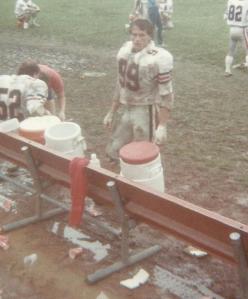 Yesterday I wrote about concussions and the difference between professionals and adolescents using Jamaal Charles as an example. What happened last night on the professional field with millions watching was completely unacceptable, professional athlete not withstanding.
Yesterday I wrote about concussions and the difference between professionals and adolescents using Jamaal Charles as an example. What happened last night on the professional field with millions watching was completely unacceptable, professional athlete not withstanding.
Late in the third quarter of the game, last night, San Diego’s defensive back Jahleel Addae (#37) ran into a pile to finish the tackle on the Denver running back. He was running at full speed and led with his left shoulder, but as he made contact with the RB his head dropped and he also made (incidental) helmet to helmet contact with the runner. This type of collision is very frequent and looked innocuous… Until you saw the after math…
Addae was bounced back, still on his feet, and began “short circuiting” for the national audience to see. He begins to look around, kind of, and stumble, kind of, and lose full control of his extremities, all of them. As a medical professional and athletic trainer I would have documented this OBJECTIVE finding as “unsteadiness and disorientation”. It looked like a boxer/MMA fighter catching a fist/kick in the face late in a boxing match; the type of reaction that any referee in those sports would stop a match for and award a TKO to the other guy.
It happens from time to time in this and other sports, that is not the issue here. The issue is that Addae returned to the game (oh, it gets worse). Here is the tweet from last night (h/t to Brady Phelps’ Vine);
From what I can piece together this play was the last of the 3rd quarter and reports had him taking the field on the first play of the 4th quarter. HE DIDN’T MISS A SINGLE SNAP! Even with the long commercial break between quarters there is a maximum of 4 minutes, but if my DVR time was correct it was between 2 and 3 minutes. This is not nearly enough time for a full concussion evaluation, by anyone.
“Maybe he was screened, like you said yesterday, Fink.”
There was absolutely no reason for a cursory “screen” in this situation, Addae showed a clear and overt sign of neurological impairment, in concussion recognition jargon: a sign. When any player shows a sign there is no screen it means Continue reading
 OK, that title may be hyperbole, but the new research out of Canada should make you take a step back and realize what our fine researchers are now able to discover. Considering the context of hockey it shouldn’t be shocking that this was found in Canada (since posting we have been informed that work was done on both sides of the border), but really for a long while now some of the best work on concussions is coming from the North, for whatever reason (no disrespect to the US scientists).
OK, that title may be hyperbole, but the new research out of Canada should make you take a step back and realize what our fine researchers are now able to discover. Considering the context of hockey it shouldn’t be shocking that this was found in Canada (since posting we have been informed that work was done on both sides of the border), but really for a long while now some of the best work on concussions is coming from the North, for whatever reason (no disrespect to the US scientists). A paramount review of concussions and their “long-term” effects has been published (or soon will) in
A paramount review of concussions and their “long-term” effects has been published (or soon will) in 
 Adrian Padilla is lucky to be back where he wants to be, on September 19th he suffered a major brain injury that required emergency removal of part of his skull. The fact that it was taken care of in time to save his life is a great thing, but after
Adrian Padilla is lucky to be back where he wants to be, on September 19th he suffered a major brain injury that required emergency removal of part of his skull. The fact that it was taken care of in time to save his life is a great thing, but after  I was recently contacted by
I was recently contacted by 
